

Site blog
The 5G wireless communications will be driven by three use cases of enhanced mobile broadband, massive machine-type communication, and ultra-reliable low latency communication.
The enhanced mobile broadband is designed for high bandwidth internet access suitable for web browsing, video streaming, and virtual reality.
The massive machine-type communication is responsible for establishing narrow band Internet applications such as narrowband IoT.
The ultra-reliable low latency communication facilitates certain delay-sensitive applications such as factory automation, remote surgery and autonomous driving.
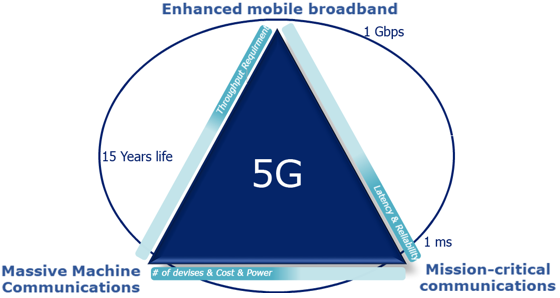
Of all the above technologies, ultra-reliable low latency communication will be the most stringent to achieve based on the 1 ms end-to-end latency, link reliability of 99.99999% and error rates that are lower than 1 packet loss in 100000 packets as recommended by the ITU.
New techniques are required to meet with the stringent latency and reliability requirements for ultra-reliable low latency communication as we migrate into the domain of haptic communications, tactile Internet, intelligent transport system and industry 4.0 era revolution.

Latency specifies the end to end communication delay, measuring the time between the sending of a given piece information and the corresponding response.
To give an example, latency can be identified in the time gap between the moment you click “stop” and the instant in which a remotely driven vehicle actually starts braking.
Reducing the latency experienced by the end users from hundredths of a second to a few of milliseconds can have an unexpected impact, leading to a real digital revolution.
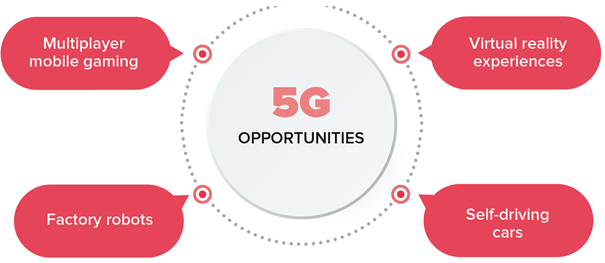
Low delays achieved by the development of 5G-based mobile networks open the way to radically new experiences/opportunities, including multiplayer mobile gaming, virtual reality experiences, factory robots, self-driving cars and other applications for which a quick response is not optional at all, but a strong prerequisite.
Focusing on self-driving vehicles, current cellular networks already provide a wide variety of tools that address some of the technology and business requirements.
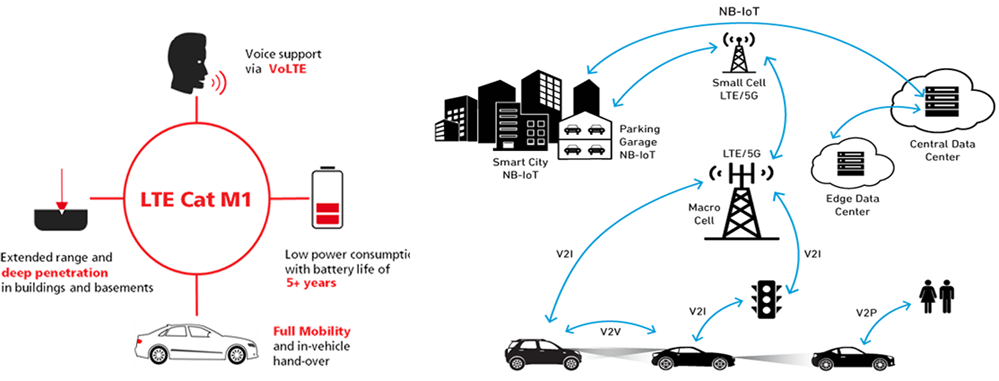
For example, LTE Category-M and Narrow Band-Internet of Things are excellent low-power sensor communication technologies.
However, in order to enable complex vehicle maneuvering, determining and recommending individual actions, e.g. acceleration, deceleration, lane changes or route modifications, the vehicles must be able to share and receive information about their driving intentions in almost real time. This low-latency demand certainly requires the development of an overall 5G system architecture to provide optimized end-to-end vehicle to everything (V2X) connectivity.

Several emerging technologies including wearable devices, virtual and augmented reality, and full immersive experience are shaping the demeanour of human end users, and they have special requirements for user satisfaction.
Therefore, these use cases of the next generation network push the specifications of 5G in multiple aspects such as data rate, latency, reliability, device and network energy efficiency, traffic volume density, mobility, and connection density.
Current fourth generation networks are not capable of fulfilling all the technical requirements for these services

Latency is highly critical in some applications such as automated industrial production, control/robotics, transportation, health-care, entertainment, virtual realty, education, and culture.
In some cases, we need latency as low as 1 ms with packet loss rate no larger than 0.01.
Several latency critical services which need to be supported by 5G are described as follows.

Factory automation includes Realtime control of machine and system for quick production lines and limited human involvement. In these cases, the production lines might be numerous and contiguous.
This is highly challenging in terms of latency and reliability.
Therefore, the latency requirement for factory automation applications is between 0.25 ms to 10 ms with a very low packet loss rate.

Intelligent Transportation Systems: Autonomous driving and optimization of road traffic requires ultra reliable low latency communication.
According to intelligent transportation systems (ITS), different cases including autonomous driving, road safety, and traffic efficiency services have different requirements.

Autonomous vehicles require coordination among themselves for actions such as platooning and overtaking.
Road safety includes warnings about collisions or dangerous situations.
Traffic efficiency services control traffic flow using the information of the status of traffic lights and local traffic situations.
For these purposes, latency of 10 ms to 100 ms with low packet loss rate is required.

Robotics and Telepresence: In the near future, remote controlled robots will have applications in diverse sectors such as construction and maintenance in dangerous areas.
A prerequisite for the utilization of robots and telepresence applications is remote-control with real-time synchronous visual-haptic feedback.
In this case, system response times should be less than a few milliseconds including network delays.
Communication infrastructure capable of proving this level of real-time capacity, high reliability and availability, and mobility support is to be addressed in 5G networks.

Virtual Reality: Several applications such as micro-assembly and tele-surgery require very high levels of sensitivity and precision for object manipulations.
VR technology accommodates such services where several users interact via physically coupled VR simulations in a shared haptic environment.
Current networked communication does not allow sufficient low latency for stable, seamless coordination of users.
Typical update rates of display for haptic information and physical simulation are in the order of 1000 Hz which allows round trip latency of 1 ms. Consistent local view of VR can be maintained for all users if and only if the latency of around 1 ms is achieved.

Health care: Tele-diagnosis, tele-surgery and tele rehabilitation are a few notable healthcare applications of low latency tactile Internet.
These allow for remote physical examination even by palpation, remote surgery by robots, and checking of patients’ status remotely.
For these purposes, sophisticated control approaches with round trip latency of 1 to 10 ms and high reliability data transmission is mandatory.

Serious Gaming: The purpose of serious gaming is not limited to entertainment. Such games include problem solving challenges, and goal-oriented motivation which can have applications in different areas such as education, training, simulation, and health.
Network latency of more than 30 to 50 ms results in a significant degrade in game quality and game experience ratings. Ideally, a round trip time on the order of 1 ms is recommended for perceivable human’s interaction with the high-quality visualization.

Smart Grid: The smart grid has strict requirements of reliability and latency. The dynamic control allows only 100 ms of end-to-end latency for switching suppliers .
However, in case of a synchronous co-phasing of
power suppliers, an end-to-end delay of not more than 1 ms is
needed.

Education and Culture: Low latency tactile Internet will facilitate remote learning and education by haptic overlay of teacher and students. For these identical multi-modal human-machine interfaces, round trip latency of 5 to 10 ms is allowed for perceivable visual, auditory, and haptic interaction.
In such scenarios, supporting network latency lower than few milliseconds becomes crucial.
Based on the applications and use case scenarios above, latency critical services in 5G networks demand an End to end delay of 1 ms to 100 ms.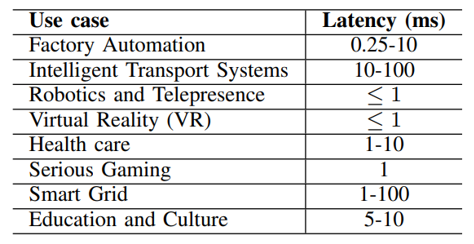
The latency requirements for various 5G services are summarized in the Table:
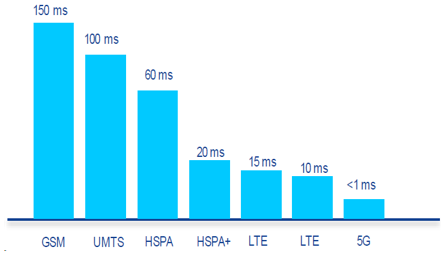
The latency of LTE is superior to that of 3G, but still inferior to what can be achieved with the wired Internet. LTE has 10 millisecond frame and 1 millisecond TTI, which are hard limit for latency. The new 5G sub-frame will be at sub millisecond level, to set a base for short latency.
5G is used across three main types of connected services, including enhanced mobile broadband, mission-critical communications, and the massive machine communications.
A defining capability of 5G is that it is designed for forward compatibility the ability to flexibly support future services that are unknown today.

Enhanced mobile broadband:
In addition to making our smartphones better, 5G mobile technology can provide new experiences as Virtual reality and Augmented reality with faster, more uniform data rates, lower latency, and lower cost-per-bit.
Mission-critical communications:
5G can enable new services that can transform industries with ultra-reliable, available, low-latency links like remote control of critical infrastructure, vehicles, and medical procedures.
Massive Machine Communications:
5G is meant to connect a massive number of sensors virtually everything through the ability to scale down in data rates, power, and mobility-providing low-cost connectivity solutions.
